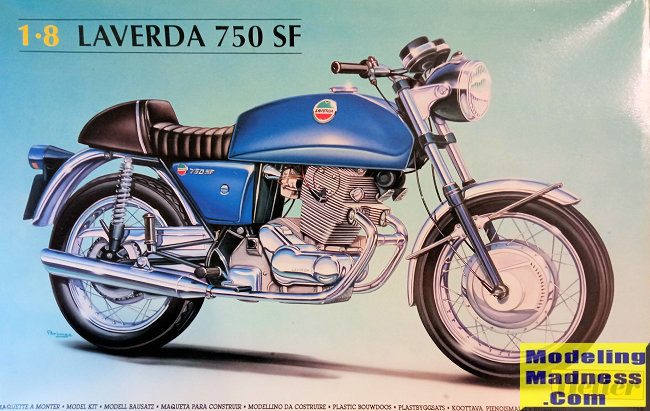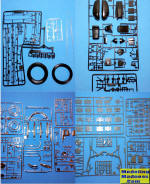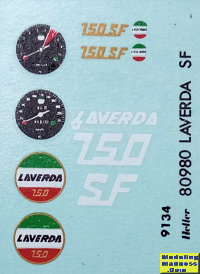
Heller 1/8 Laverda 750 SF
| KIT #: | 80980 |
| PRICE: | €15 when new |
| DECALS: | One option |
| REVIEWER: | Spiros Pendedekas |
| NOTES: | 1972 release |

| HISTORY |
The Laverda 750 is a 744 cc air cooled, SOHC, 4-stroke, parallel twin engine motorcycle, produced from 1968 to 1976. Developed from the company's 650 model, the engine's design drew heavily from the Honda CB77. The “SF” (Super Freni) version was introduced in 1970, with upgraded brakes.
The machine can be
considered as a motorcycle legend of the 1970s, remaining unique even today.
Together with the Moto Guzzi V7 Sport and Ducati Super Sport they were the
trio of bikes that most represented the Italian philosophy of two-wheeled
driving, which wants style to be combined with performance and rider
comfort. It was also the main competitor of the Honda CB750, although the
Japanese bike was much more technologically advanced. Around 18,000 units
were produced.
| THE KIT |
This is yet another one of the 1/8 motorcycle kits Heller decided to treat us from as early as 1972, reboxed, mostly in its “Competition half-fairing version from time to time. The specific kit is seemingly a late 80s - early 90s reissue, bought in 2005 from one of my hometown’s toy/hobby shops, still wrapped and at a killer price.
 The kit comes at the
very nice Heller big top opening box, carrying an attractive box art of artist
Parlange, depicting a blue 750 SF. Upon opening the box, I was greeted with a
sheer number of parts, arranged in 14 spues: four light gray styrene, two black
styrene, five chrome plated, two vinyl and the clear fret. Molding is crisp with
little flash, however the light gray sprues exhibit warping that is at areas
significant. Sadly, the plastic is too brittle, so any attempt to force
straighten the parts is an adventure by itself, the only practical approach
being to heat the parts just enough, in order to force them back into shape.
Since my kit version is 30 years old, I might assume that time has taken its
toll on those sprues (though I am not that sure that warping is due to time
passed). Interestingly, the black styrene sprues are neither brittle nor warped.
The kit comes at the
very nice Heller big top opening box, carrying an attractive box art of artist
Parlange, depicting a blue 750 SF. Upon opening the box, I was greeted with a
sheer number of parts, arranged in 14 spues: four light gray styrene, two black
styrene, five chrome plated, two vinyl and the clear fret. Molding is crisp with
little flash, however the light gray sprues exhibit warping that is at areas
significant. Sadly, the plastic is too brittle, so any attempt to force
straighten the parts is an adventure by itself, the only practical approach
being to heat the parts just enough, in order to force them back into shape.
Since my kit version is 30 years old, I might assume that time has taken its
toll on those sprues (though I am not that sure that warping is due to time
passed). Interestingly, the black styrene sprues are neither brittle nor warped.
By examining the sprues, it becomes pretty obvious that the Heller team did a
very fine job when designing the kit, meticulously measuring every bike item and
thoroughly replicating it. Of course, this yielded a huge number of parts (340
in total), dictating a complicated construction.
The distinctive engine is replicated with each cooling fin provided separately,
meaning some serious assembly job ahead. The crankcase, carburetors and all
peripherals are nicely detailed, with some of them being chrome plated. The
exhausts are chrome plated and look good.
The frame is basically supplied in two halves, onto where various smaller parts
are to be attached. The wheels are chrome plated, provided as left and right
halves that have to be joined, meaning extra care to be taken in order to
minimize the central seam. The molded-on spokes look passable, not too much out
of scale.
The drum faces, brake levers and rear sprocket look well rendered. The front and
rear fenders are aso chrome plated, with sprue gates penetrating into visible
areas, meaning some touch ups will be necessary. The vinyl tires are well
molded, but they exhibit some at areas deformation due to being pressed from the
box contents for too long.
The front forks, swing arm and chain guard look nice. The rear shock absorber
springs will have to be fabricated from supplied wire, which has to be wound
around a cylindrical piece. The handlebars are nicely detailed, as are the
instruments and various lights, with the transparencies looking well molded. The
speedo and tacho faces are represented with decals that are out of register.
The 3-piece fuel tank looks good, as does the rear cowl, the distinctive horns
and the saddle. The chain is provided in vinyl and looks convincing. Other vinyl
parts include the fork seals, the grips and numerous cables, with the vinyl
material looking strong but inflexible, so some issues are expected upon routing
the cabling.
Instructions are provided in the form of a 18-page A4 booklet written in French,
with an A3 “translation leaflet”. They contain the type’s technical
specifications, a sprues/parts list, with the definitely complex construction
spread in 12 main steps, each containing a number of sub steps, making it a
roughly 40-step process. A color callout chart is provided in the end page,
basically specifying colors for each part, which, personally, I find not that
handy, preferring to have the callouts embedded to the construction steps.
 Three identical schemes are provided, the only difference being the main color
(green, blue or the iconic Laverda orange). Colors are provided in Heller/Humbrol
codes and also in generic form. The minimal decals look averagely printed,
slightly off -registered, but in usable condition.
Three identical schemes are provided, the only difference being the main color
(green, blue or the iconic Laverda orange). Colors are provided in Heller/Humbrol
codes and also in generic form. The minimal decals look averagely printed,
slightly off -registered, but in usable condition.
Instructions start by assembling the two wheels and mounting the tires. The
front forks are then constructed, with the complete front section (wheel, fender
and fork) put together. The frame is next assembled, with its various
peripherals attached, followed by the battery and air filter assembly and
installation. The front section has to be attached to the frame at this time.
Next is the rear light construction and attachment to the rear fender, which in
turn is attached to the main frame. The swing arm is next assembled, followed by
the chain guard and the chain itself which, together with the rear wheel, are
all joined together and attached to the frame. The shock absorbers are next
constructed and attached, as is the center stand.
You are next instructed to assemble the cylinder block filet by filet, then the
main engine block and the carburettors and join everything together. The
completed engine can then be mounted to the frame, followed by the exhausts
assembly and installation.
The headlight and front instruments are next constructed and attached to the
handlebars, followed by the grips, levers and miscellaneous handlebar parts. The
fuel tank, the twin horns and saddle/rear cowl are assembled and attached at
this time, followed by the side covers and other miscellaneous parts, ending a
clearly complex, multi-part build. The various vinyl cables are to be attached
at various stages of construction.
While instructions cover every aspect of the build, they are written in such a
manner that a number of modelers will not find it too user friendly, deviating
significantly from the desired well spread, multi-step pictorial style with
color callouts given on the spot. The fact that they are written in french with
an accompanying translation leaflet only makes things more challenging,
especially for such a complex build. I have not been able to find updated
instructions on the net, the closest I got was finding well written instructions
for the similar (but not identical) “Competition” 2015 version.
| CONCLUSIONS |
This is a very well
detailed and overall accurate kit of the iconic Laverda 750 SF. In my specific
kit case, while molding is quite crisp with almost no flash, many light gray
parts are significantly warped, being, unless heat treated, at cases unusable,
with the plastic brittleness only making things worse. Clear parts are well
done, decals are average and instructions, while complete, are not user
friendly, something of prime importance for this complex, multi part build.
If you are not necessarily interested in this SF “naked” version, you might
consider going for the 2015 “half fairing” “Competition version which,
presumably will have no warping issues and has vastly updated instructions and
better decals.
Regarding the specific kit, If you find a way to overcome the warping issues,
then, with some patience, you can end with a very nice representation of the 750
SF.
Happy modeling!
January 2023 Copyright ModelingMadness.com.
All rights reserved. No reproduction in part or in whole without express
permission. If you would like your product reviewed fairly and
fairly quickly, please
contact
the editor or see other details in the
Note to
Contributors.